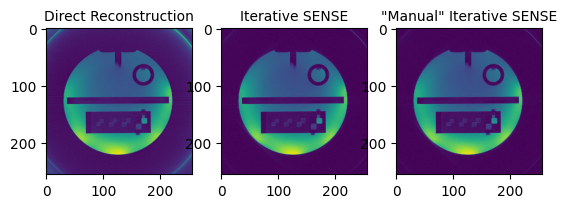Iterative SENSE Reconstruction of 2D golden angle radial data
Here we use the IterativeSENSEReconstruction class to reconstruct images from ISMRMRD 2D radial data
# define zenodo URL of the example ismrmd data
zenodo_url = 'https://zenodo.org/records/10854057/files/'
fname = 'pulseq_radial_2D_402spokes_golden_angle_with_traj.h5'
# Download raw data
import tempfile
import requests
data_file = tempfile.NamedTemporaryFile(mode='wb', delete=False, suffix='.h5')
response = requests.get(zenodo_url + fname, timeout=30)
data_file.write(response.content)
data_file.flush()
Image reconstruction
We use the IterativeSENSEReconstruction class to reconstruct images from 2D radial data. IterativeSENSEReconstruction solves the following reconstruction problem:
Let’s assume we have obtained the k-space data \(y\) from an image \(x\) with an acquisition model (Fourier transforms, coil sensitivity maps…) \(A\) then we can formulate the forward problem as:
\( y = Ax + n \)
where \(n\) describes complex Gaussian noise. The image \(x\) can be obtained by minimizing the functional \(F\)
\( F(x) = ||W^{\frac{1}{2}}(Ax - y)||_2^2 \)
where \(W^\frac{1}{2}\) is the square root of the density compensation function (which corresponds to a diagonal operator).
Setting the derivative of the functional \(F\) to zero and rearranging yields
\( A^H W A x = A^H W y\)
which is a linear system \(Hx = b\) that needs to be solved for \(x\).
import mrpro
Read-in the raw data
# Use the trajectory that is stored in the ISMRMRD file
trajectory = mrpro.data.traj_calculators.KTrajectoryIsmrmrd()
# Load in the Data from the ISMRMRD file
kdata = mrpro.data.KData.from_file(data_file.name, trajectory)
kdata.header.recon_matrix.x = 256
kdata.header.recon_matrix.y = 256
Direct reconstruction for comparison
# For comparison we can carry out a direct reconstruction
direct_reconstruction = mrpro.algorithms.reconstruction.DirectReconstruction(kdata)
img_direct = direct_reconstruction(kdata)
Iterative SENSE reconstruction
# We can use the direct reconstruction to obtain the coil maps.
iterative_sense_reconstruction = mrpro.algorithms.reconstruction.IterativeSENSEReconstruction(
kdata, csm=direct_reconstruction.csm, n_iterations=4
)
img = iterative_sense_reconstruction(kdata)
Behind the scenes
Set-up the density compensation operator \(W\)
# The density compensation operator is calculated based on the k-space locations of the acquired data.
dcf_operator = mrpro.data.DcfData.from_traj_voronoi(kdata.traj).as_operator()
Set-up the acquisition model \(A\)
# Define Fourier operator using the trajectory and header information in kdata
fourier_operator = mrpro.operators.FourierOp.from_kdata(kdata)
# Calculate coil maps
# Note that operators return a tuple of tensors, so we need to unpack it,
# even though there is only one tensor returned from adjoint operator.
img_coilwise = mrpro.data.IData.from_tensor_and_kheader(*fourier_operator.H(*dcf_operator(kdata.data)), kdata.header)
csm_operator = mrpro.data.CsmData.from_idata_walsh(img_coilwise).as_operator()
# Create the acquisition operator A
acquisition_operator = fourier_operator @ csm_operator
Calculate the right-hand-side of the linear system \(b = A^H W y\)
(right_hand_side,) = acquisition_operator.H(dcf_operator(kdata.data)[0])
Set-up the linear self-adjoint operator \(H = A^H W A\)
operator = acquisition_operator.H @ dcf_operator @ acquisition_operator
Run conjugate gradient
img_manual = mrpro.algorithms.optimizers.cg(
operator, right_hand_side, initial_value=right_hand_side, max_iterations=4, tolerance=0.0
)
# Display the reconstructed image
import matplotlib.pyplot as plt
import torch
fig, ax = plt.subplots(1, 3, squeeze=False)
ax[0, 0].imshow(img_direct.rss()[0, 0, :, :])
ax[0, 0].set_title('Direct Reconstruction', fontsize=10)
ax[0, 1].imshow(img.rss()[0, 0, :, :])
ax[0, 1].set_title('Iterative SENSE', fontsize=10)
ax[0, 2].imshow(img_manual.abs()[0, 0, 0, :, :])
ax[0, 2].set_title('"Manual" Iterative SENSE', fontsize=10)
Text(0.5, 1.0, '"Manual" Iterative SENSE')

Check for equal results
The two versions result should in the same image data.
# If the assert statement did not raise an exception, the results are equal.
assert torch.allclose(img.data, img_manual)
